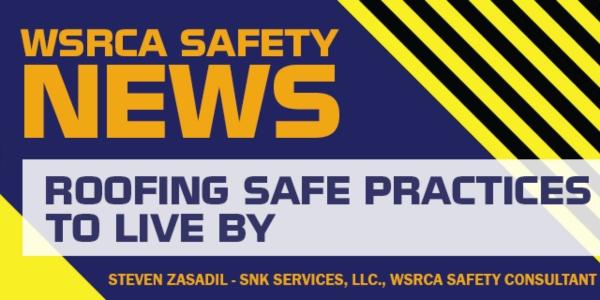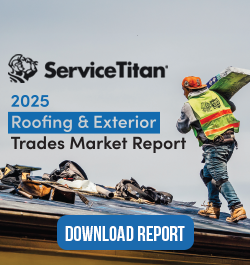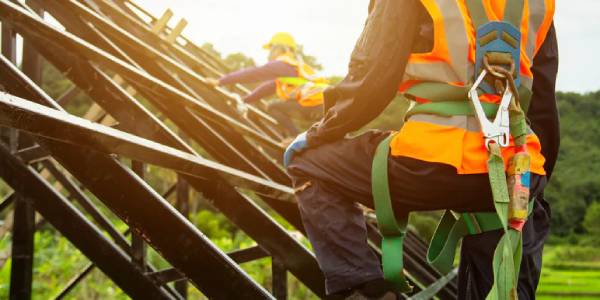10 safe roofing practices for every contractor

By Stephen Zasadil, SNK Services, LLC for WSRCA.
Use these steps to improve the safety dialogue on any jobsite and reduce complacency to prioritize best practices.
Safety is an everyday consideration in the roofing industry and unfortunately is often overlooked or placed on the back burner when working to complete a job on time. By using this guide as a reminder of the steps we can be taking before beginning each new project, we can improve productivity and efficiency while ensuring our employees are not at risk of avoidable accidents.
1 - Pre-job briefing (arguably most important)
Be sure to engage in a five-ten-minute discussion with all workers before beginning work on a rooftop, or around tools and equipment that will be used on site. Documenting these meetings helps to keep records of these talks, as well as gives your field supervisors a template to work from when leading these talks. The purpose of the pre-job briefing is to ensure that the person-in-charge (PIC) and potential workers understand the scope of the work to be performed by discussing the tasks involved. This will provide an understanding of the hazards and related safety, security, environmental controls and stimulate critical thinking and discussion.
2 - Examine site conditions
What does the site look like? Is it wet, or windy? Are there power lines, trees or traffic areas that will be part of the work area needing to be dealt with prior to beginning work. How is the weather in general? Extremely cold conditions, as well as working in high heat environments will present their own set of challenges.
3 - Personal Protective Equipment
Wearing the right Personal Protective Equipment (PPE) is one of the primary ways workers can protect themselves. Hard hat, high visibility vest (ANSI II Day/ANSI III Night), work shoes, long pants and sleeved shirts are the generally accepted minimum. However, will there be a need for eye, hearing or respiratory protection? If so, do you have the proper gear readily available to keep your workers safe?
4 - Access
How will you and your workers get to the work area? Will you use lifts? Will you use temporary or fixed ladders? If temporary ladders are utilized, have they been inspected, and are they of sufficient height to extend 36 inches above your landing? Is the ladder at the proper angle and is it secured?
5 - Layout
Is the work area laid out in such a way that having cords, lanyards or ropes underfoot will be reduced? Is material stacked so that clear walking paths are available for workers on the roof to move with as little restriction as can be avoided?
6 - Consistent housekeeping
During the process of installing new, or removing existing roofing materials of all types, debris can build up fast. Is there a plan in place to maintain frequent cleanup of work areas throughout the evolution to keep slips, trips and falls to a minimum? The days of cleaning up at the end of the day alone are behind us!
7 - Use the right fall protection
In a perfect world all work on roofs would be done on a flat surface with guard rails around the entire job. Wouldn’t that make things easier! In reality, every job will be different. They will have their own challenges and environment. For instance, some will be on a flat roof, some on a sloped roof. There are combinations of both, different slope angles, even some domed roofing jobs will come up. Part of every roofing plan must be an assessment of the fall protection means and measures that make the most sense for the job being done. The right equipment, and the right training are only effective if put into practice.
8 - Are there any specific hazards on the roof?
Openings, soft spots and skylights are all examples of hazards that need to be addressed and discussed prior to performing work at height.
9 - Is the work being performed going to change the environment?
We’ve discussed keeping the roof clean, as well as organizing material in a way to keep our workers safe. We also touched on keeping our cords and lanyards organized to avoid tripping hazards. Now, we need to look at the materials, and work practices themselves that can change the work environment and possibly create new hazards. Is there going to be cutting of tile performed on the roof, will there be water used, will the dust buildup from cutting the tile cause a slippery surface. Where will the waste material go? Will there be nails and shingles? Polyurethane? Mastic? Hot Mop? Each style of roof has its own items that need to be addressed. Don’t treat the job like one you’ve performed a dozen times. They are all different.
10 - Control the things that are out of our control
We have had our meetings, established and implemented our roofing plan. We have the correct PPE, tools, and equipment. Our material is as organized as we can make it and we are following our established safe practices to get the job done. What about the outside factors? Have we considered homeowners, personnel who are still working during construction, or pedestrians? One of the biggest hazards to pedestrians traveling near a construction zone on foot is the danger of falling debris, such as nails, tools, construction materials. Having clear signage and delineation is essential to keeping people around the site safe as well.
Original article source: WSRCA Safety News
Learn more about Western States Roofing Contractors Association (WSRCA) in their Coffee Shop Directory or visit www.wsrca.com.






















Comments
Leave a Reply
Have an account? Login to leave a comment!
Sign In